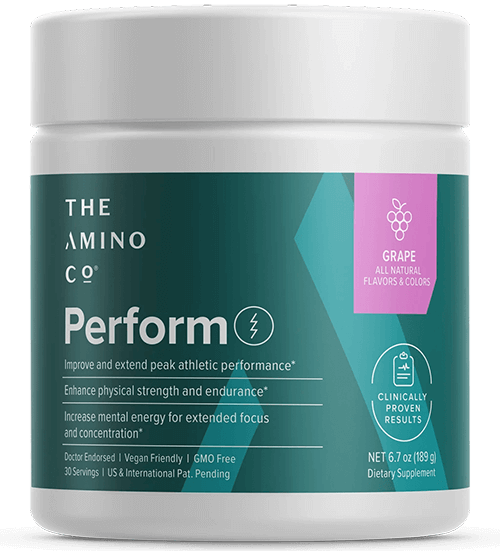What Are Amino Acids?
 By: by Amino Research
By: by Amino Research

You know amino acids make crucial contributions to your health. You may even know that dietary protein forms the most significant source of amino acids for most individuals. But can you answer the question: "What are amino acids?"
"What Are Amino Acids?"—A Simple Answer
Amino acids are simple organic compounds that contain a carboxyl group (-COOH) and an amino group (-NH2) group as well as a side chain containing carbon, hydrogen, or oxygen (two of the amino acids, cysteine and methionine, also contain sulfur).
Experts put the number of known naturally occurring amino acids at approximately 500, though only 20 of those appear in the human genetic code. Those 20 amino acids link together to form proteins in the human body, garnering them the technical moniker "proteinogenic amino acids" as well as the nickname "the building blocks of proteins."
Protein is needed for pretty much every biological process in our bodies—we absolutely cannot live without it. Because amino acids make up protein, another apropos nickname for them might be “the building blocks of life.”
The 20 common amino acids can then be subdivided into other categories based on a variety of criteria, such as:
- The locations of core structural functional groups
- Polarity
- pH level
- Side chain type (aromatic, sulfuric, and so on)
Why the Human Body Needs Amino Acids
Amino acids, in the form of proteins, make up the second-largest component (right behind water) of human muscle tissue as well as other tissues in the body. In addition to their key role as the building blocks of proteins, amino acids also contribute directly to a number of physiological functions.
Amino acids are involved in virtually every aspect of life—from muscle growth and the development of life-supporting tissues to making neurotransmitters and other chemicals necessary for our brain and vital organs to properly function. Amino acids are also the primary ingredients of most of the biochemical components in our blood and cells. Let’s take a look at how amino acids work in conjunction with proteins in our bodies.
Amino Acids: The Building Blocks of Proteins
Your body cannot absorb protein in its ingested form. Instead, it sends enzymes in your stomach and small intestine to break down the protein you’ve eaten into individual amino acids. These amino acids are able to pass through the intestinal walls and travel through the bloodstream to the liver, where they are processed and transported back to the blood, lymph, and cells. Here, the individual amino acids can be reordered and built into proteins your body can use as needed.
Protein is also made as a result of chemical reactions that occur in your body. When cells metabolize they produce byproducts. These byproducts can be broken down into amino acids that can then be used to synthesize protein.
Protein is the material that gives structure and strength to the muscles, tendons, tissues, and organs in our bodies. Protein activates most of the chemical reactions that occur in our cells as well as helping to carry crucial substances into and out of cells.
Some proteins act as antibodies that help protect us against disease and viruses, while others function as hormones that influence mood, energy levels, and libido. Proteins act as control switches for gene expression, determining which genes get turned on and off. And protein is needed to help heal wounds, repair tissue, and remove waste products produced during metabolism.
Amino acids are the foundation of it all. One molecule of protein can be made up of 100 to 1,000 amino acids linked together in what’s called a peptide linkage. The specific sequence of amino acids determines the type of protein produced.

3 Key Functions of Amino Acids
Beyond serving as the building blocks for all-important proteins, amino acids are in and of themselves important signaling factors and intermediaries in many metabolic pathways.
Plus, certain amino acids operate as precursors for neurotransmitters. Tyrosine, for example, is a precursor for dopamine, epinephrine, norepinephrine, and thyroxine. Tryptophan is a precursor for melatonin and serotonin, while histidine is a precursor for histamine and glycine is a precursor for heme, a subcomponent of hemoglobin. And aspartate (the ionic form of aspartic acid), glutamate, and glycine are precursors for nucleic acids, which form your DNA.
Here are 3 ways amino acids ensure the systems of your body operate smoothly.
- Provide energy: Like proteins, amino acids serve as a source of energy, providing about 4 calories per gram.
- Act as chemical messengers: Some amino acids, including aspartate, glycine, and serine, act as neurotransmitters in the nervous system.
- Convert to other crucial substances: Once ingested, several different amino acids can be converted to other amino acids or to glucose, fatty acids, ketones, neurotransmitters, and amino acid-based hormones.
Understanding the Different Types of Amino Acids
As mentioned earlier, there are many different types of amino acids and almost as many different ways to categorize them (you can find an in-depth explanation of amino acid functional groups here).
You could, for instance, separate the 20 standard amino acids into two groups based on whether they are polar or nonpolar. Polar amino acids have side chains with hydrophilic characteristics, meaning they are attracted to water. And, as you might expect, nonpolar amino acids have hydrophobic characteristics, meaning they repel water.
Another distinction that can be relevant is the pH level of an amino acid. Both aspartic and glutamic acid have low pH levels, making them acidic amino acids. Arginine, histidine, and lysine, on the other hand, have high pH levels, and are basic amino acids.
Then, there are six other amino acid categories you may encounter.
1. Essential Amino Acids
Your body can produce many of the amino acids it needs, but not all of them. Specifically, it cannot synthesize nine of the 20 amino acids needed to build muscle protein and carry out other key physiological functions. Those nine are known as the essential amino acids:
- Histidine
- Isoleucine
- Leucine
- Lysine
- Methionine
- Phenylalanine
- Threonine
- Tryptophan
- Valine
Essential amino acids are the only macronutrients (i.e., protein, carbohydrates, and fat) that are absolutely required in our diet. We must obtain essential amino acids from food sources or amino acid supplements since we do not have the ability to make them.
2. Nonessential Amino Acids
Nonessential amino acids, unlike essential amino acids, can be made by the body. Regardless of whether an amino acid is an essential or a nonessential, each amino acid is important as a precursor for protein synthesis, meaning the amino acid helps stimulate the production of new proteins.
Most dietary proteins are composed of at least 50% to 60% nonessential amino acids, so in most circumstances, we consume more than adequate amounts of the nonessential aminos without needing to pay particular attention to our intake.
The 11 nonessential amino acids are:
- Alanine
- Arginine
- Asparagine
- Aspartic Acid
- Cysteine
- Glutamic Acid
- Glutamine
- Glycine
- Proline
- Serine
- Tyrosine
Under certain circumstances, such as times of stress or illness, seven of the nonessential amino acids become conditionally essential because the human body cannot produce an adequate supply.
3. Conditionally Essential Amino Acids
Conditionally essential amino acids (sometimes referred to as conditional amino acids) are not normally required in the diet, but cannot be produced in sufficient quantities in some circumstances.
There are seven conditionally essential amino acids:
- Arginine
- Cysteine
- Glutamine
- Glycine
- Proline
- Serine
- Tyrosine
Some consider ornithine to be a conditionally essential amino acid too. This non-proteinogenic amino acid plays a vital role in the urea cycle.
Different circumstances cause specific conditionally essential amino acids to become essential. Proline, which the body typically synthesizes from the essential amino acid glutamate, produces cartilage and collagen. When the body is recovering from soft-tissue trauma, like muscle strain, burns, or surgery, it needs more proline and cannot always produce enough to meet its needs.
4. Branched-Chain Amino Acids (BCAAs)
The term branched-chain amino acids (BCAAs)refers to three essential amino acids:
- Leucine
- Isoleucine
- Valine
Researchers have found that these three essential amino acids—most significantly, leucine—stimulate protein synthesis, which can be very helpful for anyone seeking to increase their muscle mass.
Other health benefits linked to BCAAs include accelerated muscle recovery, balanced blood sugar levels, improved liver function, and more.
5. Sulfuric Amino Acids
Certain amino acids contain sulfur in their side chains. Fittingly, they're referred to as the sulfuric amino acids. The four common sulfuric amino acids are:
- Cysteine
- Homocysteine
- Methionine
- Taurine
Though these amino acids have important roles in the human body, individuals with celiac disease, Crohn's disease, or other disorders that cause impaired amino acid absorption may experience adverse effects such as sulfurous belches and other gassy emission.
Foods high in cysteine and methionine include: meat, poultry, fish, seafood, cheese, nuts, seeds, and legumes. Red meat, fish, and certain energy drinks can be quite high in taurine.
5. Glucogenic Amino Acids
Once ingested, glucogenic amino acids get converted to glucose via a process called gluconeogenesis. This process involves the amino acids first being converted to alpha keto acids and then to glucose. Both steps take place in the liver.
The glucogenic amino acids are:
- Alanine
- Arginine
- Asparagine
- Aspartic acid
- Cysteine
- Glutamic acid
- Glutamine
- Glycine
- Histidine
- Methionine
- Proline
- Serine
- Valine
6. Ketogenic Amino Acids
Ketogenic amino acids, in contrast to glucogenic amino acids, are not converted to glucose but rather to ketone bodies.
Two amino acids are exclusively ketogenic:
- Leucine
- Lysine
And five amino acids are considered by most to be both glucogenic and ketogenic:
- Phenylalanine
- Isoleucine
- Threonine (there is some debate about its inclusion)
- Tryptophan
- Tyrosine
Because ketones can be used by the brain as a source of energy while the body is in a fasting state or on a low-carbohydrate diet, there may be some benefits associated with an increased intake of ketogenic amino acids.

The Amino Company is dedicated to supporting the health of people everywhere with the science of amino acids. We continue to develop the world's best amino acid supplements to help prevent and treat the most common health issues people face. You can learn more about amino acids and our products here.



 833-264-6620
833-264-6620


















